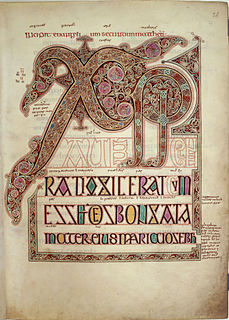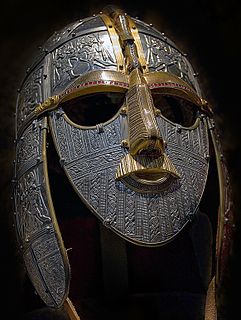Related Research Articles

Ælfheah was an Anglo-Saxon Bishop of Winchester, later Archbishop of Canterbury. He became an anchorite before being elected abbot of Bath Abbey. His reputation for piety and sanctity led to his promotion to the episcopate and, eventually, to his becoming archbishop. Ælfheah furthered the cult of Dunstan and also encouraged learning. He was captured by Viking raiders in 1011 during the Siege of Canterbury and killed by them the following year after refusing to allow himself to be ransomed. Ælfheah was canonised as a saint in 1078. Thomas Becket, a later Archbishop of Canterbury, prayed to him just before his own murder in Canterbury Cathedral.

Augustine of Canterbury was a Benedictine monk who became the first Archbishop of Canterbury in the year 597. He is considered the "Apostle to the English" and a founder of the English Church.

Justus was the fourth Archbishop of Canterbury. He was sent from Italy to England by Pope Gregory the Great, on a mission to Christianize the Anglo-Saxons from their native paganism, probably arriving with the second group of missionaries despatched in 601. Justus became the first Bishop of Rochester in 604, and attended a church council in Paris in 614.

Mellitus was the first Bishop of London in the Saxon period, the third Archbishop of Canterbury, and a member of the Gregorian mission sent to England to convert the Anglo-Saxons from their native paganism to Christianity. He arrived in 601 AD with a group of clergy sent to augment the mission, and was consecrated as Bishop of London in 604. Mellitus was the recipient of a famous letter from Pope Gregory I known as the Epistola ad Mellitum, preserved in a later work by the medieval chronicler Bede, which suggested the conversion of the Anglo-Saxons be undertaken gradually, integrating pagan rituals and customs. In 610, Mellitus returned to Italy to attend a council of bishops, and returned to England bearing papal letters to some of the missionaries.

The Anglo-Saxons were a cultural group who inhabited Great Britain from the 5th century. They comprised people from Germanic tribes who migrated to the island from continental Europe, their descendants, and indigenous British groups who adopted many aspects of Anglo-Saxon culture and language. The Anglo-Saxons established the Kingdom of England and the modern English language owes almost half of its words – including the most common words of everyday speech – to their language.
Oda, called the Good or the Severe, was a 10th-century Archbishop of Canterbury in England. The son of a Danish invader, Oda became Bishop of Ramsbury before 928. A number of stories were told about his actions both prior to becoming and while a bishop, but few of these incidents are recorded in contemporary accounts. After being named to Canterbury in 941, Oda was instrumental in crafting royal legislation as well as involved in providing rules for his clergy. Oda was also involved in the efforts to reform religious life in England. He died in 958 and legendary tales afterwards were ascribed to him. Later he came to be regarded as a saint, and a hagiography was written in the late 11th or early 12th century.
Honorius was a member of the Gregorian mission to Christianize the Anglo-Saxons from their native Anglo-Saxon paganism in 597 AD who later became Archbishop of Canterbury. During his archiepiscopate, he consecrated the first native English bishop of Rochester as well as helping the missionary efforts of Felix among the East Anglians. Honorius was the last to die among the Gregorian missionaries.
Nothhelm was a medieval Anglo-Saxon Archbishop of Canterbury. A correspondent of both Bede and Boniface, it was Nothhelm who gathered materials from Canterbury for Bede's historical works. After his appointment to the archbishopric in 735, he attended to ecclesiastical matters, including holding church councils. Although later antiquaries felt that Nothhelm was the author of a number of works, later research has shown them to be authored by others. After his death he was considered a saint.
Berhtwald was the ninth Archbishop of Canterbury in England. Documentary evidence names Berhtwald as abbot at Reculver before his election as archbishop. Berhtwald begins the first continuous series of native-born Archbishops of Canterbury, although there had been previous Anglo-Saxon archbishops, they had not succeeded each other until Berhtwald's reign.
Bosa was an Anglo-Saxon Bishop of York during the 7th and early 8th centuries. He was educated at Whitby Abbey, where he became a monk. Following Wilfrid's removal from York in 678 the diocese was divided into three, leaving a greatly reduced see of York, to which Bosa was appointed bishop. He was himself removed in 687 and replaced by Wilfrid, but in 691 Wilfrid was once more ejected and Bosa returned to the see. He died in about 705, and subsequently appears as a saint in an 8th-century liturgical calendar.
Wilfrid (II) or Wilfrith (II) also known as Wilfrid the Younger, was the last Bishop of York, as the see was converted to an archbishopric during the time of his successor. In the 10th century, two different groups claim to have taken the relics of an earlier Wilfrid from Ripon; most likely one party took those of Wilfrid the Younger. The younger Wilfrid's feast is attested in the Calendar of Winchcombe and later martyrologies, though he does not seem to have had a widespread or popular veneration.

Plegmund was a medieval English Archbishop of Canterbury. He may have been a hermit before he became archbishop in 890. As archbishop, he reorganised the Diocese of Winchester, creating four new sees, and worked with other scholars in translating religious works. He was canonised after his death.

In the seventh century the pagan Anglo-Saxons were converted to Christianity mainly by missionaries sent from Rome. Irish missionaries from Iona, who were proponents of Insular Christianity, were influential in the conversion of Northumbria, but after the Synod of Whitby in 664 the English church gave its allegiance to the Pope.
Ælfgar (Algar), according to 16th-century antiquarian John Leland, was a saint venerated at a chapel in the forest of Selwood, three miles from Mells, Somerset. Leland wrote that at the chapel "be buryed the bones of S. Algar, of late tymes superstitiously soute of by the folische commune people". There is no other surviving information on the saint, and it is presumed he was an Anglo-Saxon hermit.
Iwig was a saint venerated in Wiltshire in the Middle Ages. He was reputedly a Northumbrian monk, said to have died and to have been buried in Brittany. Historian David Dumville called him "the other principal saint of Wilton", in reference to Saint Eadgyth. He was supposedly a follower (alumnus) of Saint Cuthbert.
Botwine was a Northumbrian saint venerated at Ripon and Peterborough. He is well documented as a priest, and latter Abbot of Ripon. The Anglo-Saxon Chronicle recension E, recorded his death in the 780s in one of three Ripon abbatial obits derived from a chronicle of Northumbrian origin. Following the death of St Botwine in 786AD, his replacement, Ealdberht was elected and consecrated Abbot. Ealdberht died in 788AD, and was himself succeeded as Abbot by St. Sigered of Ripon.
Cissa of Crowland was a saint in the medieval Fenlands. He was the successor of Guthlac as abbot of Crowland, and is mentioned in Felix' Vita Guthlaci. According to the Crowland Chronicle his tomb was next to Guthlac's, and like the tomb of Guthlac, was destroyed by the Scandinavians. His relics were translated to Thorney Abbey in the 10th-century.
Ælfgifu of Exeter was an Anglo-Saxon saint, of unknown date or origin, whose relics were held by Exeter Cathedral. She is mentioned in the Old English Exeter relic-list as "the holy servant of Christ ... who would daily perform her confession before she went into church". It is possible that she is the 10th-century royal abbess, Ælfgifu of Shaftesbury wife of Edmund I, but it is "more likely" according to historian John Blair that she was not.
Osburh was an Anglo-Saxon saint who rested at Coventry Cathedral. Although there is some tradition holding her to be an early 11th-century abbess of Coventry Abbey, it is suspected that her cult predates the Viking Age.
References
- ↑ Blair, John (2002), "A Handlist of Anglo-Saxon Saints", in Thacker, Alan; Sharpe, Richard, Local Saints and Local Churches in the Early Medieval West, Oxford: Oxford University Press, pp. 495–565, ISBN 0-19-820394-2 page 528.
- ↑ Farmer, David Hugh (1992), The Oxford Dictionary of Saints (New ed.), Oxford: Oxford University Press, ISBN 0-19-283069-4
| This Catholic Church–related biographical article is a stub. You can help Wikipedia by expanding it. |
| This article about a saint from England is a stub. You can help Wikipedia by expanding it. |